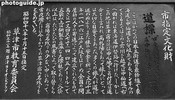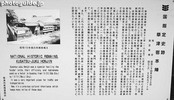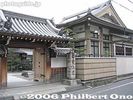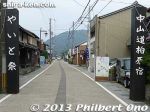 Image search results - "Honjin" Image search results - "Honjin" |

Kusatsu-juku was the fifty-second station on the Tokaido Road (following Ishibe-juku) and the sixty-eighth station (following Moriyama-juku) on the Nakasendo Road. During the Edo Period, Kusatsu was an important post town at the crossroads of both roads.The roof is shaped like a Honjin lodge, with a gate. 草津駅
|
|

JR Kusatsu Station
|
|

Kusatsu town map. Kusatsu basically developed along the old Nakasendo and Tokaido Roads as they intersected before going on to Kyoto, Shiga's neighboring prefecture.
|
|

Kusatsu River
|
|

Oiwake Guidepost road marker at the intersection of the Tokaido and Nakasendo Roads. The left side says "Left for Nakasendo Road" and the right side says "Right for Tokaido Road."
|
|

Road marker at the intersection of the Tokaido and Nakasendo RoadsThis tunnel goes under the Kusatsu River.
|
|

Road marker plaque
|
|

Kusatsu historyBeing a stage town along the Tokaido Road connecting Edo (Tokyo) and Kyoto, Kusatsu had over 70 inns for travelers. The best inn was the Honjin, reserved for daimyo warlords, Imperial family members, etc.
|
|

Kusatsu-juku Honjin on the Tokaido Road. MAP
|
|

Kusatsu-juku Honjin. the Honjin was the town's most luxurious accommodation catering to society's elite like daimyo warlords, Imperial family members including the emperor, and other dignitaries. National Historic SiteAt stage towns along the major roads like the Nakasendo and Tokaido, the Honjin was the town's most luxurious accommodation catering to society's elite like daimyo warlords, Imperial family members including the emperor, and other dignitaries. It operated during 1635 to 1870. The Honjin is now a museum.
This Honjin in Kusatsu is a very impressive example of traditional architecture. It is designated as a National Historical Place. It underwent a complete renovation and reconstruction during 1989 to 1995. (In case you wonder why such an old building looks so new.) Admission 200 yen. 10-min. walk from Kusatsu Station.
|
|

Kusatsu-juku Honjin entrance. This Honjin in Kusatsu is a very impressive example of traditional architecture. It is designated as a National Historical Place. It underwent a complete renovation and reconstruction during 1989 to 1995. Admission 200 yen.
|
|

Genkan Hiroma entrance hall straight ahead. It was the entrance for daimyo feudal lords. 玄関広間
|
|

About the Kusatsu-juku Honjin
|
|

Sekifuda name plates in Genkan Hiroma entrance hall. This is what you see when you enter the Honjin through the Genkan Hiroma entrance hall. The name plate for the warlord staying at the lodge was displayed. 玄関広間This is what you see when you enter the Honjin through the Genkan Hiroma entrance hall. The name plate for the warlord staying at the lodge was displayed here.
|
|

Kusatsu-juku Honjin corridor. Pass by numerous Japanese-style rooms. 畳廊下畳廊下
|
|

Kusatsu-juku Honjin guest book. See the names of Kira and Lord Asano both of whom once lodged at this Honjin (at different times). These two men later became adversaries which led to the legendary chushingura or vendetta of the 47 masterless samurai. 大�You can see the names of Kira and Lord Asano both of whom once lodged at this Honjin (at different times). These two men later became adversaries which led to the legendary chushingura or vendetta of the 47 masterless samurai.
大福帳
|
|

Jodan no Ma: Kusatsu-juku Honjin's best room in the house. Reserved for daimyo warlords, emperors, etc. 上段の間
|
|

Jodan no Ma - Kusatsu-juku Honjin's best room in the house. Reserved for daimyo warlords, emperors, etc. 上段の間
|
|

Jodan no Ma - Kusatsu-juku Honjin. The Gyokuza raised tatami mats was where the lord or Emperor slept or sat. 上段の間Reserved for daimyo warlords, emperors, etc.
|
|

Jodan no Ma - Kusatsu-juku Honjin's best room in the houseReserved for daimyo warlords, emperors, etc. The room had an elevated tatami mat for the person to sit and sleep on.
上段の間
|
|

Mukae Jodan no Ma 向上段の間向上段の間
|
|

Mukae Jodan no Ma. Painting on the fusuma sliding doors by Matsumura Keibun. 向上段の間
|
|

Urinal (made of lacquered wood) for warlords. The room has two tatami mats. Right below the urinal is a bamboo mat. Above is a small shoji paper window to provide light.
|
|

Toilet (made of lacquered wood) for warlords. This is a separate room adjacent to the urinal. It also has two tatami mats. The walls are plain and not decorated. The toilet had a box which was likely replaced each time it was used. 上段雪隠This is a separate room adjacent to the urinal. It also has two tatami mats. The walls are plain and not decorated. The toilet had a box which was likely replaced each time it was used.
Jodan settin
上段雪隠
|
|

Marker for Emperor Meiji's visit and outdoor garden
|
|

Outdoor garden
|
|
|

Yudono bath room for warlords. The hot water was heated nearby and carried to this room. 湯殿
|
|

Bath for feudal lordsLooks kind of small to me.
湯殿
|
|

Kitchen (Daidokoro doma). Dirt-floored room with wood-heated stoves. High ceiling with no chimney, but the ceiling has a covered opening. 台所土間
|
|

Honjin owner Tanaka's house
|
|

Honjin owner Tanaka's house
|
|

Honjin owner's house
|
|

Ceiling
|
|

Kusatsu-juku Kaido Koryu-kan is a history museum with various exhibits showing Kusatsu's post town history. Admission 200 yen. You can buy a set ticket good for both the Honjin and this history museum. 草津街道交流館
|
|

Kusatsu-juku Kaido Koryu-kan. Terminals are provided to find information about Kusatsu. 草津街道交流館 MAP
|
|

Kusatsu-juku Kaido Koryu-kan 草津街道交流館
|
|

Kusatsu-juku Kaido Koryu-kan. Sample food from the old days, dinner on left and breakfast on right. 草津街道交流館
|
|

Photo op room at Kusatsu-juku Kaido Koryu-kan. You can dress up as a traveler on the Tokaido/Nakasendo Road and take a picture of yourself. You can even sit in the palanquin. A tripod is provided too. 草津街道交流館
|
|

Palanquin at Kusatsu-juku Kaido Koryu-kan 草津街道交流館For photos.
|
|

Ukiyoe prints of Kusatsu-juku at Kusatsu-juku Kaido Koryu-kan 草津街道交流館
|
|

Kusatsu-juku Kaido Koryu-kan草津街道交流館
|
|

Model of the town at the Kusatsu-juku Kaido Koryu-kan 草津街道交流館
|
|

Waki Honjin souvenir shop and restaurant脇本陣
|
|

Temple with road marker
|
|

Closeup of road marker indicating the Tokaido Road to the right and Nakasendo to the left.
|
|

Yaito Matsuri sign
|
|

Gate of the Honjin, the town's most exclusive lodge. The Honjin is gone, and only the gate remains.
|
|

A private house sits on the Honjin site.
|
|

Honjin stone marker (reads "Tsuchiyama-juku Honjin ato"). By 1843, Tsuchiyama's population was 1,505. There were two Honjin and 44 inns.
|
|

The Honjin was the town's most exclusive lodge reserved for daimyo lords, government officials, and even Emperor Meiji. Each post town on the Tokaido had a Honjin.
|
|

The Tsuchiyama-juku Honjin opened in 1634 on the occasion of Shogun Tokugawa Iemitsu staying here on his way to Kyoto. The Tsuchiyama family was appointed as the Honjin's caretaker.
|
|

Inside the side entrance of the Tsuchiyama-juku Honjin. If you want to see inside the Honjin, call to make reservations. Admission 300 yen. Phone: 0748-66-0007 (English not spoken)
|
|

The entrance is decorated with wooden signs (sekifuda 関札) of the VIPs who stayed here. Whenever a VIP stayed here, the wooden sign with his name on it would be displayed on the gate.
|
|

The Hosokawa daimyo from Kumamoto stayed here quite a few times. When a daimyo was lodging at the Honjin, passers by were required to get off their horses while walking past the Honjin as a gesture of respect.
|
|

The Tsuchiyama-juku Honjin operated until 1870 when the shukuba system was abolished. For over three centuries, the Tsuchiyamas took care of the Honjin. Their 15th-generation descendants live here now and take care of it as a tourist attraction.
|
|

This dirt-floored entryway dates from the Edo Period. It's slightly bumpy and packed hard with a glossy black color. It definitely looks centuries old. Was happy to touch some earth of the Edo Period.
|
|

A short walk through the long Honjin brought me to the Jodan-no-Ma (Upper Class Room) where the shoguns, daimyo lords, and Emperor Meiji stayed. 上段の間
|
|

The Jodan-no-Ma has elevated tatami mats on which the VIP sat and slept. This is called the Gyokuza. The room size is 8 tatami mats. Tsuchiyama Honjin address: 滋賀県甲賀市土山町北土山1628 玉座
|
|

Honjin guest books signed by all the shoguns, daimyos, and other VIPs who stayed here. All of the guest books since the 17th century have been preserved.
|
|

This lists the dates when members of the Imperial Family lodged here. Emperor Meiji came here three times. The first time was on Nov. 3, 1868 when he lodged overnight and celebrated his birthday. The next two times, he only took a break here.
|
|

The Honjin's garden has a stone monument indicating that Emperor Meiji stayed here. It was during the first year of the Meiji Period when he stayed here, and it was in Tsuchiyama when he celebrated his first birthday during the Meiji Period.
|
|

To celebrate his birthday, Emperor Meiji gave sake and dried squid to all the families in Tsuchiyama. The Honjin's Tsuchiyama family went to great lengths to prepare for the Imperial stopover. Besides renovating the house, they dug a new water well.
|
|

Page from the Honjin's guest book. Shogun Tokugawa Yoshinobu, the last shogun, also lodged here and signed the guest book. Saigo Takamori also stayed here.
|
|

Room next to the Jodan-no-Ma. The Honjin has numerous rooms. This is one of the very few original Honjin remaining in Japan. There's another one in Shiga in Kusatsu.
|
|

Tsuchiyama-juku on the old Tokaido Road. On the right is the site of the Waki Honjin which is near the Honjin. If no VIPs were staying at the Waki Honjin, ordinary travelers could also stay here if they had the money. This building is not original.
|
|

Site of the Waki Honjin, used as a secondary Honjin when the Honjin was already occupied. If two daimyo lords were staying in town at the same time, the higher-ranked lord would stay at the Honjin. 脇本陣
|
|
|
|
|